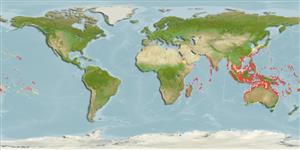Common names from other countries
Environment: milieu / climate zone / depth range / distribution range
Écologie
Récifal; profondeur 0 - 50 m (Ref. 96667). Tropical; 38°N - 36°S, 32°E - 134°W
Indo-Pacific: East Africa to Hawaii.
Length at first maturity / Taille / Poids / Âge
Maturity: Lm ? range ? - ? cm Max length : 20.0 cm TL mâle / non sexé; (Ref. 101422); âge max. reporté: 30 années (Ref. 100471)
Description synthétique
Morphologie
Spermatophore has a total length of 0.0016 cm, a stalk that is 0.0090 cm long and 0.0020 cm wide and an ampulla that is 0.0060 cm long and 0.0045 cm wide (Ref. 2889).
Maximum depth from Ref. 85195. Intertidal to 50 m (Ref. 85195). Also occurs from littoral and subtidal zones (Ref. 2884); associated with coral reef, reef flats, rocky platform, rubble, sand (Ref. 81753), seagrass bed and algal mat (Ref. 106227). On coral heads in lagoons (Ref. 74671). Reported to feed on holothurians (Ref. 106232). Opportunistic omnivore (Ref. 100471).
Life cycle and mating behavior
Maturité | Reproduction | Frai | Œufs | Fécondité | Larves
Members of the order Decapoda are mostly gonochoric. Mating behavior: Precopulatory courtship ritual is common (through olfactory and tactile cues); usually indirect sperm transfer.
Barnes, D.K.A. and R.J. Arnold. 2001. (Ref. 2884)
Statut dans la liste rouge de l'IUCN (Ref. 130435)
statut CITES (Ref. 108899)
Not Evaluated
Not Evaluated
Utilisations par l'homme
Pêcheries: commercial
| FishSource | Sea Around Us
Outils
Plus d'informations
Taille/ÂgeCroissanceLongueur-poidsLongueur-longueurMorphologieLarvesAbondance
Sources Internet
Estimates based on models
Preferred temperature
(Ref.
115969): 24.4 - 29, mean 28 (based on 1166 cells).
Catégorie de prix
Unknown.
